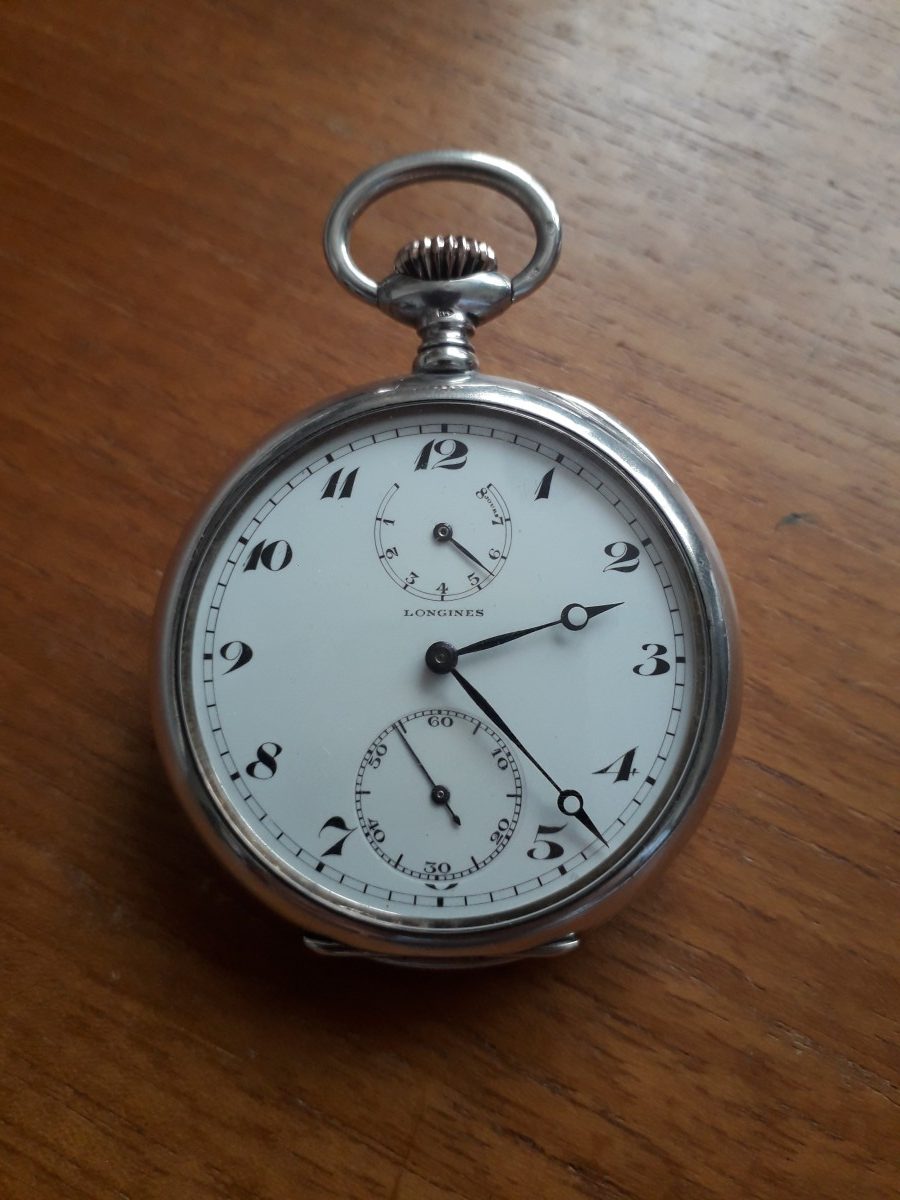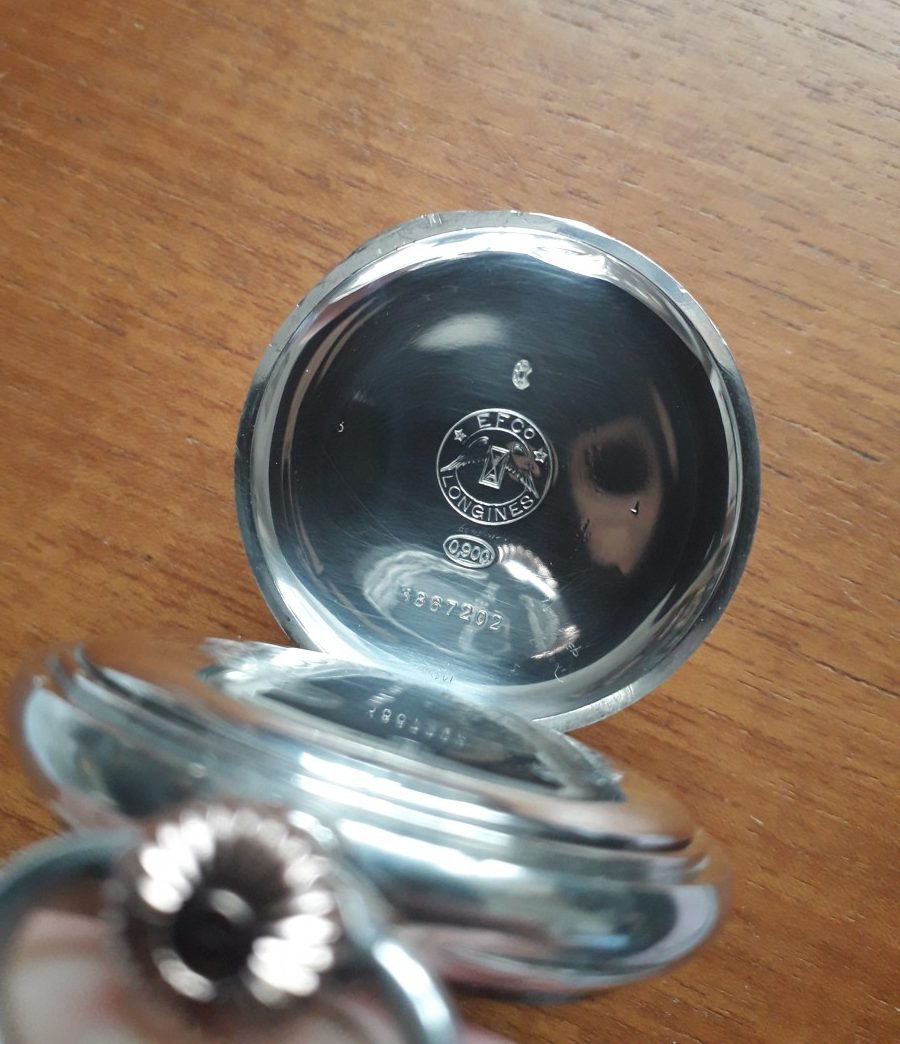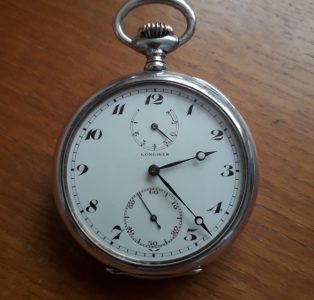Longines is a very well-known watch name to most people – both aficionados and the public. It is an old brand, commencing in 1832 by Auguste Agassiz, who opened a watch comptoir (business) in Saint-Emier in the Jura region of Switzerland. The name Longines in French means “long meadow” – a somewhat odd name for a watch company, so one assumes a nearby field had some significance! Auguste was joined in 1852 by his nephew Ernest Francillon (an economist) in order to evolve and improve the business. This included penetrating the US market, which they did very successfully, and, with overall demand increasing, they decided it would be more efficient and profitable to offer ready-made watches via a production line type model. For this they required new premises and thus a new factory was opened on the banks of the Suze river in 1866. In 1889 Ernest copyrighted the Winged Hourglass and EFCo (Ernest Francillon & Co) as trademarks.
New watch innovations flowed. One of the first, a chronograph, was produced in 1874 (calibre 20HC) – at first glance looking like a pocket watch. Longines was then in the vanguard of wrist chronographs with reference 13.332 in 1913. A collaboration with P Van Horn Weems (US Navy) resulted in the “Weems“, a special watch to aid navigation. Charles Lindbergh wore this in his amazing 1927 flight from New York to Paris. In 1931, and in collaboration with Lindbergh, Longines produced a variant of this called the Hour Angle Watch.

Then Longines’ first automatic watch appeared in 1945 with caliber 22A. By this time they were pretty dominant in the sport timing arena, and In 1952 were given the accolade of providing the timekeeping for the Helsinki Olympics. They were also innovative in the electronic field, making in 1954 a portable quartz timepiece linked to a camera. This was used for photo-finish applications such as horse racing and athletics. In 1972 more innovation occurred when they produced a liquid crystal display (lcd) and this was used in a watch in conjunction with Texas Instruments in the US. These two inventions were somewhat ironic, as they probably caused Longines their problems later in the Seventies (others capitalising on the technology better) when eventually in 1983, they fell into the arms of the business that would later become The Swatch Group. Longines remains a well-known company and still sells much product at fair prices, being able to use the in-house movement maker ETA and other commonalities with others in the Swatch stable – such as Tissot. However, they are not in the haute horlogerie hand-made field, with most pieces being from £500 – £1500. Recently though the company has reproduced some of it’s historic editions, such as the 24 Hours, Lindbergh Hour Angle and the Weems Second Setting watches. These are all very interesting and are some of the more expensive offerings at between £2,000 – £6,000
Moving on, firstly with a little religious story. I am not a particularly religious person, despite having resided at a boarding school originally set up to “provide education for the sons of Congregational ministers”. In the early 1800’s, when the school was founded, it was in fact free to attendees, kept going by donations from local congregants. During my tenure there in the Seventies, oddly, religious education was viewed by most (including the majority of masters) as somewhat of a sideshow and an irrelevance. This perception was certainly not aided by the fact that the two teachers I experienced, were, by most standards, quite dotty – a fact also acknowledged by other staff. One surely did have mental issues, although of high intelligence. He was usually late and drove his aged moped into class, manoeuvred, parked, then slowly removed his pudding basin helmet, ex – RAF goggles, gauntlets and trench coat! This particular individual also had a speech impediment which, aside from making him difficult to understand, also caused spluttering and nose blowing of which the latter really did trumpet. This combination of tardiness, unclear words and our constant messing about/ridiculing, meant that our religious instruction was almost non-existent. Needless to say most souls dropped the subject as soon as possible and we left school pretty ignorant of it all, let alone “believing” or wishing to take up The Cloth!
So, for most of my adulthood I have been an atheist, and to be frank pretty Dawkinish. However, over the past 15 years or so I have explored religion (mainly Christianity) more and have perhaps moved a little to an agnostic stance Why? Well, whilst I do believe in the science of the Earth’s creation, I still struggle that pure fate and evolution came up with the human body – or for that matter say an eye. So, maybe there was a helping hand. Equally though, I cannot accept the beginnings (or some of the later miraculous happenings) as related in the Bible. So, I guess I have a foot in both camps and now feel that is as far as I will ever go. Right, I think that will do!
Returning to the matter in hand, all this nicely sets the scene. Despite all the aforementioned, I go on religious retreats! I enjoy discussing religion but also the peaceful ways of, say, monasteries and their inhabitants – all usually in tranquil settings. It is, so to speak, good for my soul! One monastery that I go to fairly often holds an annual auction to raise funds for their various projects. Friends and supporters donate items of interest to be sold, with the Community retaining the proceeds. A few years ago I decided to coincide a stay with the auction date as it all sounded fun. I had noted from some of the auction information that there were a couple of watches lots. One was a small square gold Rolex ladies watch, the other a silver Longines pocket watch. I had arrived a day early so was able to view these in relative peace. The Rolex was discarded as it was only in 9ct gold, did not work and was pretty beaten up. The Longines was of more interest. It was dirty but working, and I was able to see inside and note some of the details. One aspect that I was particularly taken with was the 8 day power reserve dial, which I felt was unusual.

The auctioneer (an ex-professional and the brother of, well, one of the Brothers!) was there, and I asked him if the watch had a reserve and what did he think it could go for? There was no reserve but he felt maybe £250. Later than evening, ensconced in my small room, I fired up the internet on my mobile and did some Googling. Try as I might I could only find one vaguely similar watch and that was via an auction house result. The text stated that “this Longines 8 day watch is a rarity” and it had sold for a little over £800. The next day was the auction and beforehand I was able to view again and decided that I would try for it. I had though noticed two chaps who were also taking an unwelcome interested in “my” watch, and then proceeded to open a lap top and poke about. I was by now both worried and irritated! This was made all the worse by the fact that due to another engagement, I would have to depart before the auction started at 2 pm. I would therefore need to leave some instructions with the auctioneer. I had another chat with him and decided that I would go up to £500. Anyway, much later on that day he called me to say that I had been successful at £460. And yes, another bidder was one of the men from the previous day but dropped out at that point.
First off, I am no expert in pocket watches so frankly my knowledge of them when I bought this watch was minimal. I know a little more now, so, what have we got? Well it is a silver cased pocket watch from the early 20th century, with a case size of around 50 mm x 10 mm. Starting at the front, the dial can be accessed by the hinged glass. Underneath is a white porcelain dial – it does not seem to be enamelled metal. There is a minute rail track in black round the outer edge. Inboard of this are quite large numerals in the Breguet style. At 12 is the power reserve register noting each day in numerals up to eight. Under the eight is noted in small script Jours. Each day is pointed to by a small blued leaf shaped hand. This dial is only partial and is missing it’s top portion due to the imposition of the numeral 12. Under the dial is noted Longines. At 6 is a running seconds register with the dial indicating up to 1 minute. There is an outer track, denoting in 5 second intervals by numerals. Under this is the fragmented remains of the 6 numeral – a little cute!. The main hands are blued and are in the the typical Breguet style.
At the case top there is a conventional chain bow, within which is the onion-shaped crown in rose gold. The bow is interesting as has British hallmarks – the Lion Passant (so, sterling quality), makers name – NC, and the London Lion – very small and indistinct. I cannot however see a date stamp which is odd. The crown is simple, winding the watch and on pulling out, moves the hands.

Moving to the rear, there is a first hinged case back. On the inner side is stamped the EFCo and Longines names, plus the winged hour-glass. There is the Swiss Bear assay stamp and silver content stamp of 0.900. There is also the watch serial number. Additionally, there is also a feint hand engraved service date of 7/29. Under this it says “93 – 81 only” but am not sure what this means?

There is then an inner case (or cuvette), and engraved on the outer side notes 7 Grands Prix wins and various award medals. Opening this up, and on the other side is again the Swiss Bear, silver content, serial number and the number 3. There is some perlage decoration here.

Now looking at the movement. This is a high quality lever type, with 8 blued screws and 5 visible jewels. Inscribed on the main plate is Longines, 19 jewels, the serial number again and on a bridge A (advance) and R (retard). Further down is the calibre number – 19,41.

Although I have no idea when the watch was last serviced, when fully wound it keeps pretty good time – maybe loosing 1 minute or so a day. As there seems scope to advance the beat, I plan to do some more checking here and make some adjustments.
A year or so ago I managed to obtain a little more information via an acquaintance at Longines. The watch was made in 1918 and was retailed – not in the UK which I would have laid money on, but apparently a jeweller in Beirut no less. This is odd as the case and movement are clearly made by (or for) Longines in Switzerland, with the chain bow made in England! There may not be much more to know – an official “extract from archives” apparently requires the watch to be sent to Switzerland (which I cannot be bothered with) – unlike their wrist watches for some inexplicable reason! When I go to Switzerland again I may take with me and call on the Longines museum.

To complete the picture I managed to source a nice contemporary silver graduated chain and fob from a specialist shop in London – Atlam. I paid some £160 but you can get somewhat cheaper if you are prepared to do some scavenging.
In conclusion, I like the watch. It is a useful size with an attractive dial. It is practical too without the need to wind every few days. It also seems to be of high quality of it’s type and is in good condition. Lastly, from a quality maison!
P.S. I did find another similar watch sold at auction – exactly the same, but this one was double signed and also had red 24 hour numbers as well. That sold for some £1,000. I feel the monks got more than they hoped for, and I had a good deal too!
Words: The Writer
Pictures: The Writer, except for the Lindbergh ad image sourced from the excellent The Watch Book II by Gisbert Brunner

